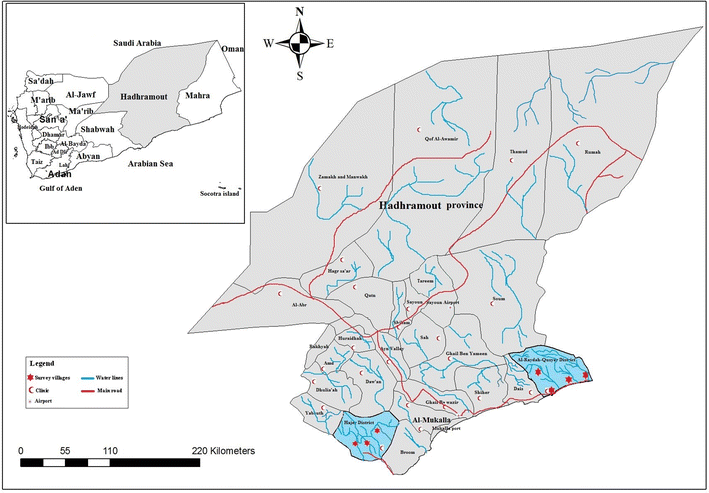Frequencies distribution of dihydrofolate reductase and dihydropteroate synthetase mutant alleles associated with sulfadoxine-pyrimethamine resistance in Plasmodium falciparum population from Hadhramout Governorate, Yemen
- PMID: 26693691
- PMCID: PMC4688959
- DOI: 10.1186/s12936-015-1035-2
Frequencies distribution of dihydrofolate reductase and dihydropteroate synthetase mutant alleles associated with sulfadoxine-pyrimethamine resistance in Plasmodium falciparum population from Hadhramout Governorate, Yemen
Abstract
Background: Malaria in Yemen is mainly caused by Plasmodium falciparum and 25% of the population is at high risk. Sulfadoxine-pyrimethamine (SP) had been used as monotherapy against P. falciparum. Emergence of chloroquine resistance led to the shift in anti-malarial treatment policy in Yemen to artemisinin-based combination therapy, that is artesunate (AS) plus SP as first-line therapy for uncomplicated malaria and artemether-lumefantrine as second-line treatment. This study aimed to screen mutations in the dihydrofolate reductase (dhfr) and dihydropteroate synthetase (dhps) genes associated with SP resistance among P. falciparum population in Hadhramout governorate, Yemen.
Methods: Genomic DNA was extracted from dried blood spots of 137 P. falciparum isolates collected from a community-based study. DNA was amplified using nested polymerase chain reaction (PCR) and subsequently sequenced for Pfdhfr and Pfdhps genes. Sequences were analysed for mutations in Pfdhfr gene codons 51, 59, 108, and 164 and in Pfdhps gene codons 436, 437, and 540.
Results: A total of 128 and 114 P. falciparum isolates were successfully sequenced for Pfdhfr and Pfdhps genes, respectively. Each Pfdhfr mutant allele (I51 and N108) in P. falciparum population had a frequency of 84%. Pfdhfr R59 mutant allele was detected in one isolate. Mutation at codon 437 (G437) in the Pfdhps gene was detected in 44.7% of falciparum malaria isolates. Frequencies of Pfdhfr double mutant genotype (I51C59N108I164) and Pfdhfr/Pfdhps triple mutant genotype (I51C59N108I164-S436G437K540) were 82.8 and 39.3%, respectively. One isolate harboured Pfdhfr triple mutant genotype (I51, R59, N108, I164) and Pfdhfr/Pfdhps quadruple mutant genotype (I51R59N108I164-S436G437K540).
Conclusion: High frequencies of Pfdhfr and Pfdhps mutant alleles and genotypes in P. falciparum population in Hadhramout, Yemen, highlight the risk of developing resistance for SP, the partner drug of AS, which subsequently will expose the parasite to AS monotherapy increasing then the potential of the emergence of AS resistance. Study findings necessitate the continuous monitoring of the efficacy of the national anti-malarial drugs policy in Yemen. In addition, monitoring SP efficacy using molecular markers that has shown to be a practical and informative method for monitoring the partner drug of AS.
References
-
- World Health Organization. World malaria report. Geneva; 2014.
-
- NMCP. Yemen’s national malaria control and elimination strategic plan 2011–2015. Ministry and Public Health and Population, primary Health Care Sector, National Malaria Control Programme. 2011.
-
- WHO . World malaria report, 2012. Geneva: World Health Organization; 2012.
-
- NMCP. Yemen’s national malaria control and elimination strategic plan 2006–2010. Ministry and Public Health and Population, primary Health Care Sector, National Malaria Control Programme. 2006.
Publication types
MeSH terms
Substances
LinkOut - more resources
Full Text Sources
Other Literature Sources
Research Materials


